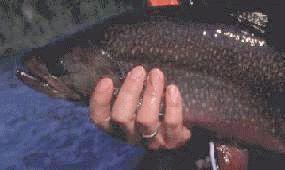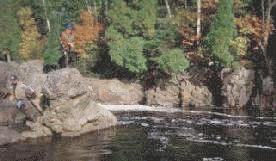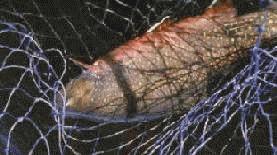
Brook Trout
by John Holt
The only sight prettier than that of a wild brook trout leaping above the surface of a tree-lined, sapphire-colored pool would have to be a brace of brookies high above the water. All trout are beautiful and the golden trout is just flat out spectacular, but a brookie in full spawning dress brings home with a colorful vengeance all of the reasons for chasing trout.

These trout have green-black backs highlighted with lighter wavy lines (vermiculations). Blood-red or even purple spots are splattered across the sides of the brook trout, and these dots are surrounded by sky-blue aureoles. The flanks of the fish give way subtly from green to yellow and then blazing orange that is almost red in autumn's spawning males. A line of black separates this riot of color from a perfectly white belly. The fish's fins are also bright orange or red, divided by black and then dipped in white. Spawning males are distinguished from the females by a kype and often, a pronounced, humped back.
To see a fish such as this arching over a clean, burbling brook in fall, with the aspens blasting yellow into a sharp blue sky is almost enough to make a person forget fishing. Almost. Feeling the fish's pull the end of your line, and then holding this perfection in your hands, complete the experience.
Brookie Is A True Native
The brook trout (Salvelinus fontinalis) is a true North American native that is found down south in Georgia, up north near the Arctic Circle and way out west in Washington and Oregon, not to mention the far-flung reaches of the Canadian provinces, South America and Europe. And in the maritime possessions of Canada, and down below the equator in Argentine waters, the trout exceed 30 inches and a dozen pounds more frequently than is healthy to ponder for any length of time. Beautiful, big-fish madness lurks in unexplored still waters running deep and undisturbed.
In Maine, the South and the Midwest, a 2-pounder is a trophy. In western states like Montana and Wyoming, 6 pounds is bragging size. As with most fish, the best brook trout water is also the most difficult to reach and is usually quite large — big lakes, brawling rivers. In Labrador, on some of the finest rivers, many of the most productive "pools" are a half-mile or more long. Big brook trout are extremely susceptible to angling pressure, so once they are discovered by anglers, the time of trophy fishing is limited to a matter of just a few seasons.

Before the onrushing development associated with "civilization," the brook trout was the only species of trout fly fishers chased in the eastern United States. Then, as numbers declined and the brown trout became established as a European substitute, the brookie declined in popularity in the late 19th century. Some of the reasons for this were the facts that browns grew larger more quickly, and also, because they were somewhat of a novelty.
The tiger trout is a cross between a brook and brown trout. The cross has the brook's vermiculations and the brown's coloring. This cross has an extremely aggressive disposition, but unfortunately only about one-third of the young are able to develop fully because of a disease inherent in the sac-fry. This cross rarely occurs in nature and is unable to naturally reproduce because it is a salmonid mule (sterile adult). The hybrid is an excellent quarry for the dry fly fisherman.
Brook trout have experienced a resurgence in popularity and today thrive in streams, rivers, lakes, ponds — anywhere with clean, cold water. In some mountain lakes, the fish do so well and are present in such great numbers that they become stunted, hammer-handled specimens. Many lakes in the West have limits of 30 or more fish per angler per day and even with heavy fishing pressure, trout numbers remain high and constant. Unfortunately, these trout are often big-headed and skinny-bodied.
Brook trout spawn from September, in the northern limits of their range, on through December in the southernmost regions. A 6-inch fish will lay at the most 200 eggs, but 15-inch females will produce well over 1,000. The trout construct redds in areas of good flow, especially around upwelling springs. They will spawn in extremely small brooks. However, in lakes, their demands are not as rigid, and a nest can be located in either shallow or deep water.
Brook trout may live 10 years, but a 6-year-old fish is 1-in-10,000. And despite the ability of the trout to reproduce in astounding numbers, brookies are more susceptible to warm water temperatures than any of the major trout species. These fish seem to grow best where predators exist in healthy numbers. Other species are needed as a natural means of brook trout population control. Some of the best brookie water also produces trophy northern pike and extremely large walleyes. Farther north, lake trout and arctic char keep the populations down to manageable levels through predation.
When the fish are reared in hatcheries, even with breeding among normally-colored fish, albino trout occur with some small degree of regularity. The fish are more orange than pink and the eyes may be black or pink. Albinos in the wild are an extreme rarity for the obvious reason that they are easy to spot by predators.
Brook trout are related to lake trout, arctic char and bull trout. In many Western rivers and tributaries where both brook and bull trout are present, hybridization is a common occurrence. In fact, the introduction of brookies in the West is a major reason for the decline of pure-strain native populations of bull trout.
Beaver Ponds Mean Brook Trout
When fishing for brook trout, one type of water comes to mind that is indelibly linked with the species — beaver ponds. Sure, other species make use of this fabricated environment, but at nowhere near the extent of the squaretail. You can take brookies in dammed-up mosquito-infested bogs in northern Wisconsin, in small rodent-designed ponds hiding behind thickets of tag alder in world-class grizzly country in northwest Montana and in charming little lakes sitting in alpine meadows way up in the mountain passes of Colorado. Wherever a beaver can block or hinder the progress of water as it obeys its gravitational downhill imperative, you will find brook trout, often in great numbers and of surprisingly large dimensions considering the fact that many ponds are less than an acre in surface area. These waters are rich in nutrients and, as a result, filled with aquatic insects along with larger bait such as leeches, crayfish, and small frogs.
The best beaver pond for the angler is a new or relatively new one. The older the impoundment, the more silt and debris that has accumulated on the bottom. The fate of all beaver ponds is to eventually turn into swamps, then grassy meadows — eutrophication is the name of the process. A 2-year-old beaver pond is prime stuff, worthy of serious investigation with a red-and-white spoon in the 1/16th or 1/8th-ounce range cast with an ultra-light rig and 2-pound (4-pound maximum) line. The delicate setup allows you to thoroughly work the water without causing a trout stampede to deep cover. And a 1-pound brookie provides superb sport on this gear. Spinners work, but not like the red-and-white spoon.
The pond needs to be approached with stealth, maybe in a crouch, and you might have to use bankside bushes for cover. If trout are rising and feeding on surface insects, cast well beyond them and bring the spoon through the pond with a steady retrieve. If feeding fish are not in evidence, cast to brushy banks, just behind the dam itself, up into any inlets and across any visible channels. The trout's coloration is ideal for blending into this environment. Water that at first appears barren, may hold hundreds of brookies who cannot be caught until the sun is behind the pines and shadows cover the water. Only then will the fish venture out into the open to feed.
Perhaps even more than the brown trout, the brookie is a creature of dawn and dusk. The fish are curious, but easily spooked and extremely cautious. Aggressive browns and rainbows are frequently observed at midday, but this behavior is almost nonexistent in squaretails who prefer the overhead security that deepening shadows on the water provide.
Look For Springs In Lakes
One last location that is good water for all trout, but especially so for brookies, is found in lakes. During the heat of summer, when the water begins to reach uncomfortable levels for the brookies, the fish seek out springs shooting forth life-saving streams of cold water from beneath the lake bed. Finding these trout magnates is difficult, but one tip is to look for pockets of open water in among aquatic weed growth.

On a chain of lakes such as those found on the large river systems of Ontario, finding brook trout is difficult work in July, until you cast a spinner over the edge of a bed of lily pads into clear water sometimes no more than 5 feet in diameter. A good fish will often hit the lure immediately, before it has dropped even a couple of inches.
A thermometer will indicate that the water in the center of this pool is often 15 degrees cooler than the water surrounding the opening. Similar pockets nearly always hold at least one and often three or four trout and each location reveals itself to the thermometer to be a cold-water spring. The brookies here are commonly over a pound and up to 3 pounds. Big, dominant fish take the choice spots in a diminishing environment. This type of diminishing environment normally turns up fish during the dog days of summer.
The things to remember with brook trout are to fish any beaver-dam ponds or lakes, look for isolated, big-drainage systems and fish any springs you discover in lakes.
